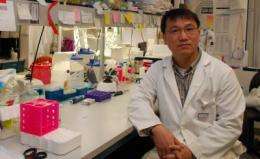Mitochondria restructuring protein provides new therapeutic target for heart disease

Mitochondria are often called cellular "powerhouses" because they convert nutrients into energy. But these tiny structures also help determine cellular lifespan. Scientists at Sanford-Burnham Medical Research Institute (Sanford-Burnham) are now discovering how mitochondria alternate between duplicating and fragmenting and how these events help cells adapt to diverse physiological conditions.
In a paper published November 18 in Molecular Cell, a team led by Ze'ev Ronai, Ph.D. discovered that the protein Siah2 regulates mitochondrial fragmentation under low oxygen conditions. The significance of these findings is demonstrated by the heart's response to oxygen shortage and ischemia, the tissue damage caused by lack of oxygen, when the researchers inhibited Siah2. In cells and mice lacking the protein, heart cell death was prevented. As a result, tissue damage was reduced in a mouse model that mimics a heart attack.
"Our work reveals key aspects to controlling mitochondrial dynamics in response to low oxygen tension," said Dr. Ronai, associate director of Sanford-Burnham's National Cancer Institute-designated Cancer Center and senior author of the study. "By manipulating mitochondrial dynamics, we can help cells adapt to ischemic conditions in a way that might translate into new treatment options for patients who've experienced a heart attack."
Siah2 is an ubiquitin ligase, meaning its job is to tag other proteins with a molecule called ubiquitin, marking them for destruction. This way, Siah2 controls which proteins are active and which are destroyed in response to environmental signals. In this study, Dr. Ronai and his team found that one such signal—low oxygen, a condition also known as hypoxia—engages Siah2 in the control mitochondrial fragmentation process by allowing two key regulators (the proteins Drp1 and Fis1) to get together. Their union, however, increases mitochondrial fragmentation, cell death, and cardiac tissue damage under ischemic conditions.
"In a hypoxic environment, increased Siah2 activity takes a protein called AKAP121 out of the picture, freeing up the Drp1-Fis1 complex to shift the balance in favor of mitochondrial fragmentation," explained Hyungsoo Kim, Ph.D., postdoctoral researcher in Dr. Ronai's lab and first author of the study. "This change in mitochondrial structure is accompanied by changes in function that lead to heart cell death under stress, giving us a new understanding of how cells respond to hypoxia and a new target to prevent the damage often seen in ischemic injury."
When the researchers mimicked heart attack in cells and mice lacking Siah2, AKAP121 levels increased (keeping a damper on the Drp1-Fis1 relationship), mitochondrial fission was reduced, and fewer heart cells died. Under hypoxic conditions, Siah2-deficient mice fared better than their normal counterparts.
Dr. Ronai credits a collaborative approach for the success in demonstrating both Siah2's role in mitochondrial fragmentation and its physiological importance. Teaming up with the laboratory of Sanford-Burnham's Mark Mercola, Ph.D. helped unravel Siah2's role in cardiovascular function. In addition, contributions by the laboratory of Andrew Dillin, Ph.D. at the Salk Institute for Biological Studies revealed the roles of Siah2 and mitochondrial fragmentation in the lifespan of C. elegans, a worm model.
Dr. Ronai and his team are now searching for chemical compounds that inhibit Siah2, which they hope can be further developed into new therapies for cardiac damage and cancer.

















